The first transistor in space: little-known aspects of the space race
(Start. End - Winner of the transistor race in space )
On November 3, 1957, the Soviet Union launched the Second artificial satellite of the Earth with the first living “passenger” - the dog Laika. The sensational success and secrecy of the projects are still left “behind the scenes” by the outstanding achievements of specialists in the field of electronic equipment, whose participation in the space race by Russian literature is practically not considered, which is completely unfair.
A curious fact: from the beginning of the first flights of man (not into space - just the first flights of the Wright brothers) until the launch of the Soviet Sputnik-1 took about the same time as after Sputnik-1 to our days. George Ludwig 1 (George H. Ludwig) 1 in his book [2] notes that space themes have become firmly established in our life, while the original meaning of the terms in everyday life was quite noticeably distorted: for example, when people say “bring a transistor here”, they often have It means a transistor radio, and the words “turn on the satellite” should be understood as connecting to satellite communications.

Fig. 1 Russian fans at the 2011 Rugby World Cup are cheering on their team, waving a banner reading: “We won the space race.” (Mike Hewitt / Getty Images) [3] .
Few people know and remember that space exploration is not only the development of rocket engines, spacecraft and life support equipment for astronauts (astronauts, taikonauts ...), but also sophisticated electronic equipment, with more or less intelligence, more or less high-tech "element base" (transistors, resistors, relays ...). The instrumental race in space is sometimes no less interesting than the race that we used to call space. And the consequences of this race are not obvious both to the broad masses, and, admittedly, to specialists.
On the Internet, in particular, on Wikipedia [4] , one can read that the first transistors in space were used in the first American satellite Explorer 1. On the Soviet satellites, they appeared in a limited number not starting from Satellite-3 (launched on May 15, 1958 ) [5] , not at all from Luna-3 (launched on April 20, 1960) 2 [6] . True, there are allegations that P401 fused-diffusion transistors appeared already in the transmitter of the first artificial Earth satellite [7] , [8] and, thus, “our successes in space and in transistors appeared to the world at the same time” [8] . But there are skeptics who believe that transistors on the first Soviet artificial satellites simply could not be, since our country "was far behind" technologically from the United States and in special-purpose equipment, at least until the late 1970s lamps. As an argument, supporters of this version cite the AVM-25 on-board computer calculator of the MiG-25 fighter, which in 1976 stole VI in Japan. Belenko. The AVM-25 car was not only on the lamps - it was analog 3 , which for cool Internet cushions (that is, non-specialists) is tantamount to sentencing. Why it was so - the topic of a separate article. The conviction that domestic electronics and microelectronics lagged far behind the western one, and now they are completely dead, is quite common. What are the jokes on the topic of "the largest microelectronics in the world", "chips with four legs and two carrying handles", "domestic microprocessor on lamps", etc.
Let's try to deal with the aspect of the space race associated with the use of transistors, that is, in fact, with the beginning of the use of semiconductor electronics in space. We will try to find the sources of the myths that have arisen and, if possible, dispel them, at least in the part concerning the equipment of the first satellites.
The equipment intended for satellites must meet increased requirements for dimensions, mass, power consumption and reliability, so it is not surprising that it was semiconductor transistors that were considered active elements of electronic transmitting devices in both the USSR and the USA. time crystal triodes). In the book by E.Ya. Pumper “Crystal Diodes and Triodes” of 1953 [10] 4 shows a photograph that vividly demonstrates the comparative dimensions of a vacuum tube and a transistor.
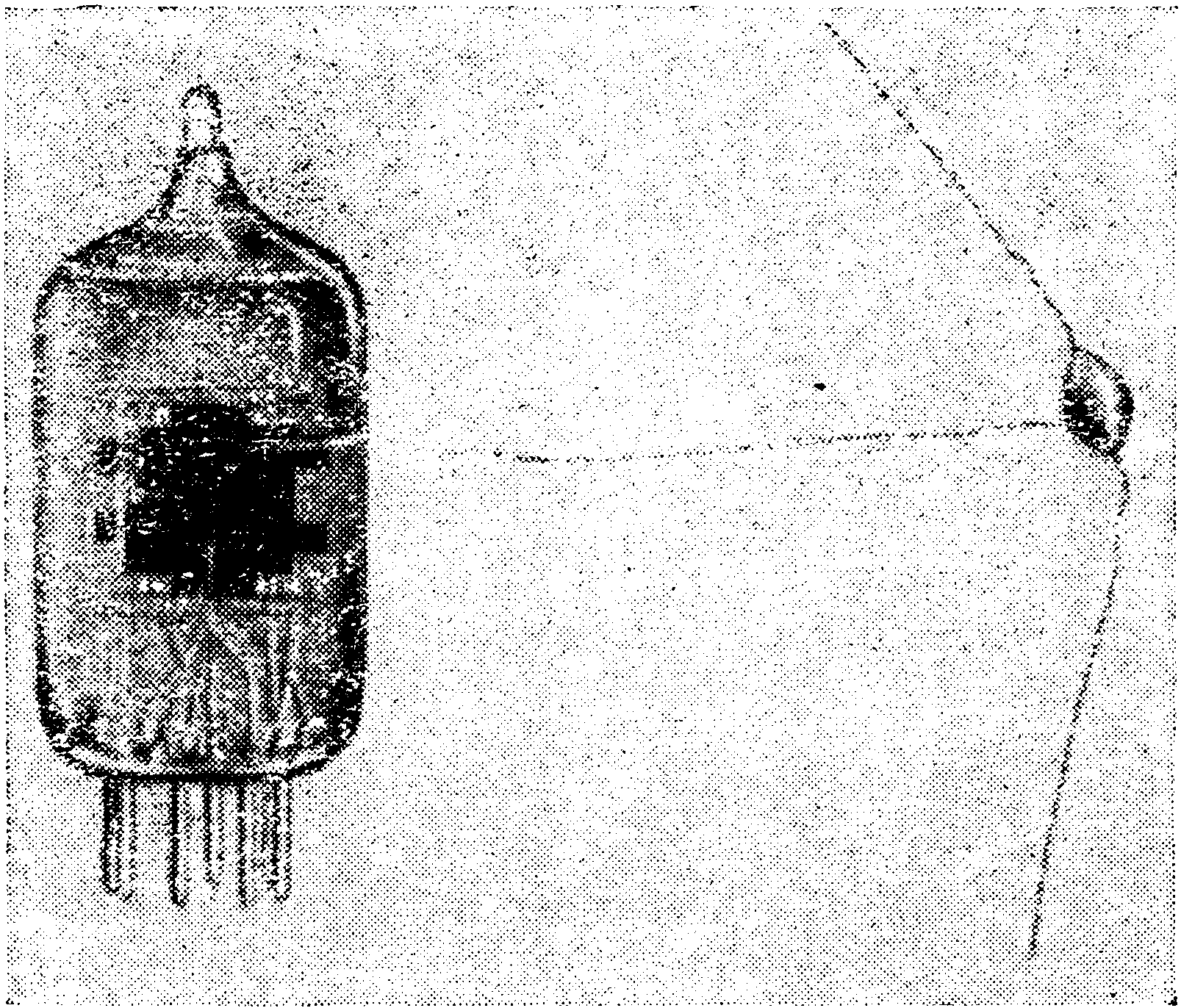
Fig. 2 Comparison of the lamp and the semiconductor transistor from [10] .
In the time since the invention of the transistor Shockley, Bardin and Brattein in the late 1940s and before the beginning of the space age, transistors have changed quite noticeably. Dot transistors were supplanted by planar, planar - floatable, and so on, until they were all supplanted by planar [11] . Silicon transistors supplanted germanium, although not immediately. The first silicon transistor was made in 1954 by Texas Instruments [12] 5 , and, looking ahead, the transistors of this particular company were used in the first American satellites [14] .
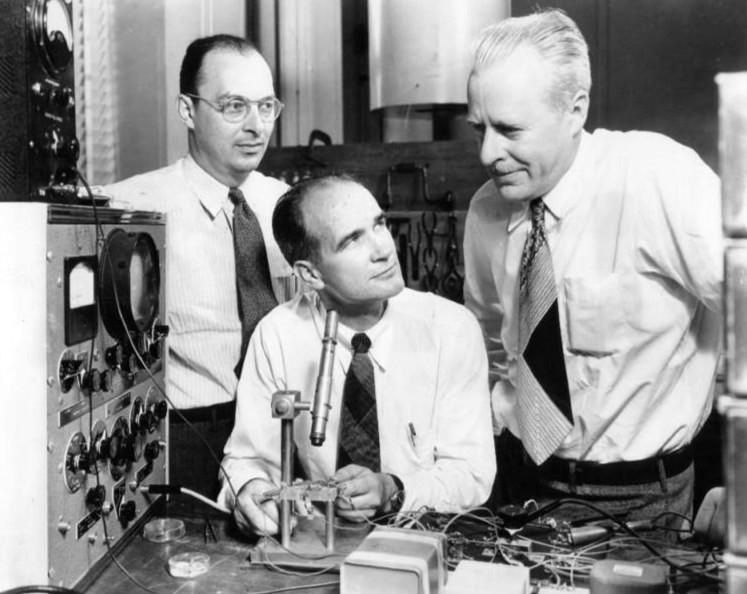
Fig. 3 Bardin, Shockley and Brattein in the Bell Lab
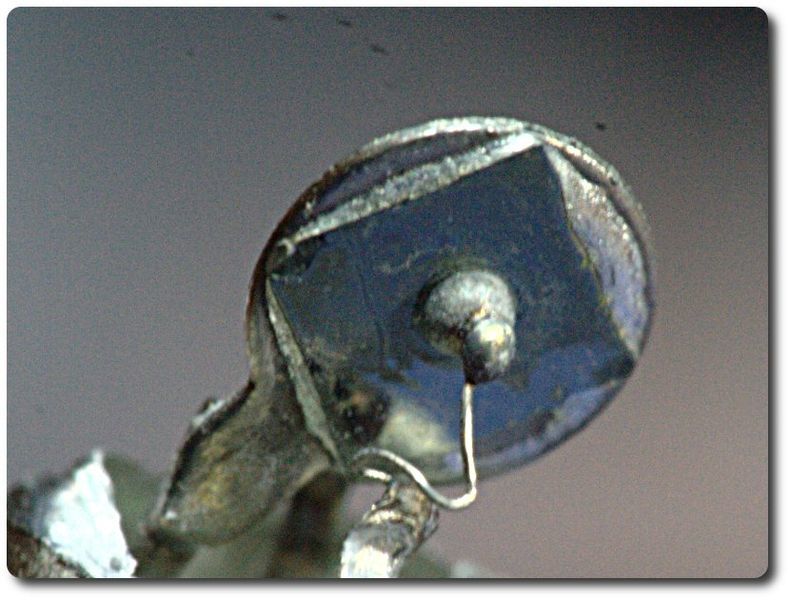
Fig. 4 Alloy transistor. Square plate - base, on the one hand, an emitter bead is welded to it, on the other - a collector bead (from Wikipedia)
Semiconductor production in the USSR began in 1947 with a line for the production of germanium detectors for radar, exported from Germany. The group under the direction of A.V. Krasilov in NII-160 (now - JSC "NPP" Source "them. Shokina) was engaged in development. S.G. Madoyan - a graduate of the Moscow Institute of Chemical Technology - in 1948-1949. developed a model of the first point germanium transistor in the USSR [15] , [16] . The first laboratory sample worked no more than an hour, and then required a new setting [15]
In 1950, the transistor theme appeared in the Central Research Institute-108 MO (now the Central Research Institute for Radio Engineering named after Academician A. Berg JSC), the Physics Institute of the Academy of Sciences, the Leningrad Physical-Technical Institute and other organizations. The first point transistors are made by V.E. Lashkaryov in the laboratory at the Institute of Physics of the Academy of Sciences of the Ukrainian SSR. Because of the secrecy of research, often at that time different research groups did almost the same thing, obtained similar results and made discoveries independently of each other. This situation lasted until November 1952, when a special issue of the American journal Proceedings of IRE, now Proceedings of IEEE, was published, entirely devoted to transistors [15] . At the beginning of 1953, the Deputy Minister of Defense, Academician A.I. Berg, prepared a letter to the CPSU Central Committee on the development of transistors, and in May, the Minister of Telecommunications Industry, M.G. Pervukhin, held a meeting in the Kremlin on semiconductors, at which they decided to organize specialized research institute of semiconductor electronics (NII-35, now NPP "Pulsar"). In the "Pulsar" transferred laboratory A.V. Krasilova, in which they created the first prototype in the USSR of a germanium plane ("layered") transistor. This development formed the basis of serial devices P1-P3 (1955) and their modifications [15] .
Fig. 9 The first germanium and silicon Soviet transistors
The first silicon alloy transistors appeared in the USSR in 1956 (104-106), then in 1956-1957. - germanium P401-P-403 (30-120 MHz), and also P418 (500 MHz). As we see, the launch of the first artificial satellite of the Earth in the USSR was the production of both germanium and silicon transistors, although even the 1960s, the percentage of usable silicon transistors output was only 19.3% [15] . According to [15] , in 1957, the Soviet industry produced 2.7 million transistors (for comparison, in the United States, the output of transistors this year was 28 million, and the number of different types reached 600). The first germanium transistors worked in the temperature range up to +85 o C [11] 6 and their characteristics were unstable, which turned away from the transistors both the military and the political leadership of the USSR.
Among the “transistor builders” is a popular story, according to which transistors are widespread, thanks to the ingenuity of inventors who have declared that the transistor cannot be used for “special applications” and the military short-sightedness [17] . Apparently, this story has a real basis.
The creators of the first transistor could not know everything that he would be capable of, but the Bell Labs administration understood that the significance of this discovery was enormous, and did everything in its power to find out about the discovery in scientific circles [18] . On June 30, 1948, a large press conference was appointed to announce the opening. But before showing the transistor to the public, it had to be shown to the military. It was hoped that the military would not classify this development, but it was clear that they could do it. On June 23, Ralph Bown 7 showed a transistor to a group of officers. He showed a crystal with wires and the fact that it can amplify an electrical signal more effectively than a massive vacuum tube. He also told them that they were going to hold exactly the same demonstration in a week, without formally asking them for permission. The military discussed this issue among themselves after the demonstration, but in the end, none of them spoke in favor of classifying this topic. Either because of his own short-sightedness, or as an additional protection against the encroachments of the military, it was stated that "the transistor is expected to be used in hearing aids for the deaf ”) [19] . As a result, the press conference was held without interference [20] . The New York Times magazine posted a note on the transistor on page 46 in the Radio News section after a “lengthy note on the resumption of reporting by an incomparable Miss Brooks” [17] .
In early September 1951, Bell Labs held symposia in Murray Hill, New Jersey, during which engineers explained in a fairly general way how to make point transistors, and talked about current progress with alloy transistors. At the same time, nothing was said about the specific manufacturing process and military applications. The first symposium was attended by over 300 people (mostly military), each of whom paid a contribution of $ 25,000 (twenty-five thousand dollars in 1951 8 ) [21] . Many firms wanted to produce transistors on their own rather than buy them, and many succeeded. Philips manufactured a transistor at all without attending these seminars, using only information from American newspapers. It should be noted that AT & T did not contribute, but did not prevent other companies from producing transistors [21] .
In 1951, there were only four US transistor companies for commercial applications: Texas Instruments, International Business Machines (IBM), Hewlett-Packard and Motorola. They received licenses for those same $ 25,000 with low royalties. They were invited to the second symposium in April 1952, where the secrets of making transistors were fully disclosed. By 1952, there were eight manufacturing firms, by 1953 - fifteen, and by 1956 there were at least twenty-six companies producing germanium transistors, with an income of more than $ 14 million a year. In this case, the US military was the main consumer of transistors. In 1952, semiconductor manufacturers from Bell Labs signed military contracts worth over $ 5 million [21] . The share of research funding (R & D, Research and Development) from the military from 1953 to 1955 increased to 50% [22] .
With all this, the future of semiconductors for the military remained unclear, because the transistor was “noisy” compared to lamps, it withstood smaller loads, could be damaged by sudden voltage surges, its characteristics were unstable in the temperature range, and the frequency range was relatively narrow. The situation was aggravated by a wide variation of parameters between two transistors. The price of transistors was also high: the first samples were worth $ 20, by 1953 they had fallen in price to $ 8, while the lamps were worth about $ 1 [21] . Fairchild Semiconductor silicon mesa transistors were sold by IBM in the amount of 100 pieces for $ 150 (each) in 1958 - while Germanic transistors cost less than $ 5 at that time [23] . In the mid-1960s, these same transistors began to cost less than 10 cents per share [24] .
What about hearing aids? They actually appeared in the United States in 1952-1953 [25] , [21] , and this was the first non-military use of the transistor. AT & T issued free licenses for use in hearing aids to commemorate the work of Alexander Bell with the deaf [21] .
Unfortunately, this story has a little-known sad continuation, which concerns the Soviet Union already. Professor Ya.A. Fedotov (author of one of the first monographs on transistors in 1955 [26] ) in 1994 in the article “Electronics SOS!” [27] mentions a “murderous” sentence that was carried out at a meeting of the Council of Ministers of the USSR in 1956: “Transistor never will not enter into serious equipment. The only promising area of application for him is hearing aids ... ". Familiar expressions, is not it? Fedotov writes: "This distrust of the transistor and the craving for the old tube technology were explained by the lack of understanding of the new situation in electronics." And this is a year before the launch of the first satellite! Thus, everything that the American "transistor builders" avoided and successfully avoided, turned upon domestic ones: secrecy, lack of centralization, and a lack of understanding of the prospects by the top political leadership of the USSR. Obviously, in such conditions, the transistors had little chance of getting on board.
Was there an alternative to transistors? After all, again, "on board" you can not put any device, but only with the required characteristics of reliability. The alternative appeared in the late 1940s, i.e. almost simultaneously with transistors, in the form of rod radio tubes. Due to the secrecy of the topic, it is quite difficult to track the history of the invention and development of this type of radio tubes, and often have to be content with information from online forums [28] .
June 1946. The USSR Council of Ministers entrusts Plant 617 (in the near future with the All-Union Research Institute No. 617 (NII-617) with an experimental plant of the State Committee of the Council of Ministers of the USSR on Radio Electronics) in Novosibirsk, the development of ultra-miniature and extra-strong lamps for onboard computer systems of aviation equipment. VN was appointed to lead the work. Avdeeva.

Fig. 10 Valentin Nikolaevich Avdeev
Valentin Nikolaevich Avdeev was born on May 16, 1915 in the city of Kotelnich of the Vyatka province. After receiving primary education, he worked at the Svetlana plant (now PJSC Svetlana) in Leningrad. He graduated from the factory technical school, then studied at the All-Union Correspondence Institute of Technical Education in 1934-1938. In 1941, he was sent for an internship in the USA for half a year (to the plants of Radio Corporation of America, RCA) to study the production of radio tubes. When the Great Patriotic War began, together with the staff of the plant was evacuated to Novosibirsk. There he worked first as a site master, from 1942 - chief engineer of the plant, from 1943 - deputy head of the laboratory. Subminiature radio tubes were developed by the design bureau of the plant 617 by 1947, and from 1948 secret production began. Since 1949, the work "Molecule" on the creation of ultra-miniature lamps of increased vibration resistance has been opened. On the basis of the laboratory number 1 created NII-617, the director of which is appointed Avdeev.
Rod tubes were practically free from the drawbacks of the "ordinary" tubes and, unlike the transistors of that time, could work in the full temperature range. A series of radio tubes was created: 1 17, 1 18, 124, 129 and 124. In 1960, the magazine [ Radio ] published an article [29] devoted to the principles of operation of rod radio tubes, in which the advantages of this type were noted, as well as the limiting frequency of more than 200 MHz was declared, which more than met the requirements for the frequency of receiving radio signals from the first artificial satellite Earth (see [30] ).
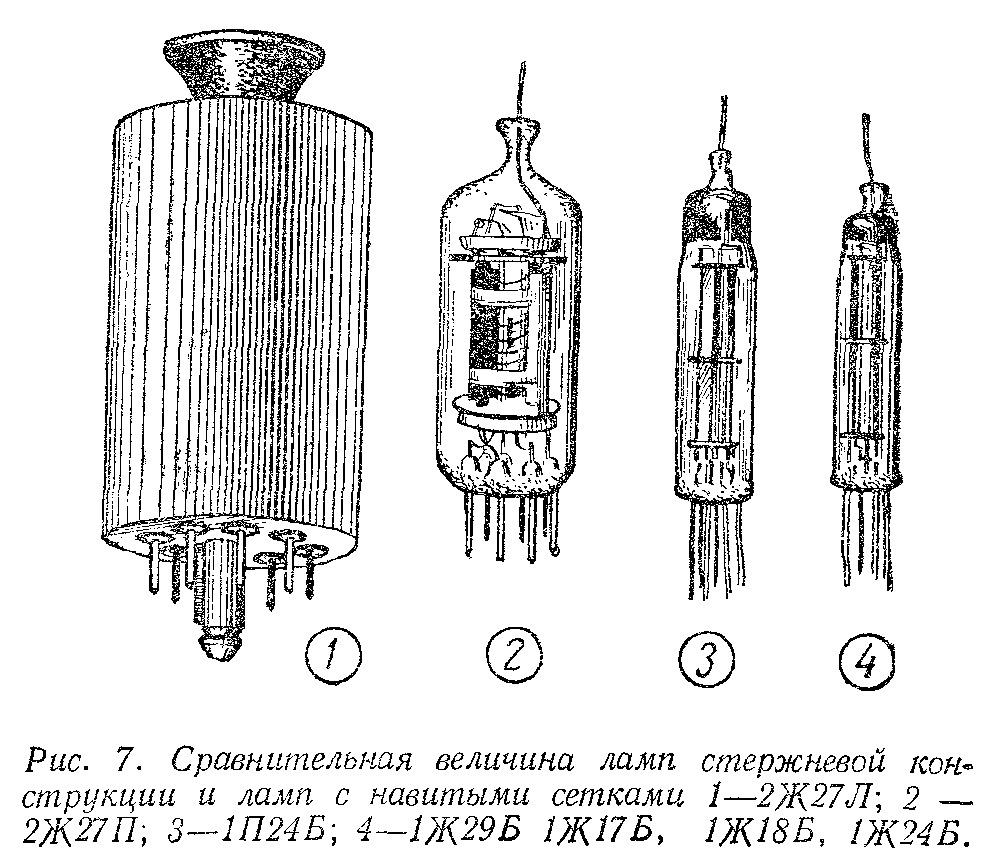
Fig. 11 Comparison of “ordinary” and rod radio tubes from an article in the magazine “Radio” [29]
For the creation of rod radio tubes V.N. Avdeev was elected a corresponding member of the USSR Academy of Sciences in 1958 (the same year that SP Korolev was elected a full member). This is despite the fact that V.N. Avdeev never defended dissertations - neither the candidate, nor the more doctoral.
The authors of the article in the magazine “Radio” complain: “Several years ago, when semiconductor devices appeared, some radio specialists were inclined to immediately“ bury ”the electronic lamp. The lamp, which for decades brought electronics to one triumph after another, suddenly revealed many shortcomings ... An electronic lamp compared to a semiconductor triode undoubtedly has several disadvantages, but the remarkable advantages of the lamp are well known ... ". And they add: “Unfortunately, it is necessary to note that the question of the scale of use, and, consequently, the production of rod-shaped lamps, is not resolved sufficiently quickly, despite the fact that these lamps have existed for many years and were highly appreciated.” In these words - a clear distrust of the "newfangled" transistors.
Rod radio tubes were used not only in space and aviation - they were used to create radio stations for the GRU and KGB special forces (R-353 Proton), a portable radio station R-126, a complex of MARS radio stations for the Ministry of Internal Affairs, etc. [31 ] .
Our country launched not only the first artificial satellite of the Earth (and then brought the first man into space), but after the first satellite, 2 full-fledged space laboratories were launched within 7 months - Satellite-2 with Laika and Satellite-3, with the help of which in particular, natural radiation belts were discovered Zamlí 9 . The American first satellite Explorer 1 was 3 months ahead of Sputnik-3, however, by its “functional” characteristics it was closer to Sputnik-1, and its weight was almost 4 times smaller. The launch of Sputnik-1 caused the deserved respect of scientists, bewilderment and even the fear of the inhabitants in the West, the universal joy and triumph in the USSR and the storm of emotions of politicians. I will cite only two characteristic statements by Soviet and American politicians (I quote from [34] ). First Secretary of the CPSU Central Committee N.S. Khrushchev: “It seems that the name Avangard reflected the confidence of the Americans that their satellite would be the first in the world. But ... our Soviet satellite became the first, it was he who was in the vanguard ... ". Senator and future US president Lyndon Johnson: "I do not believe that this generation of Americans wants to come to terms with the situation when they have to fall asleep every night under the light of the communist moon." Not surprisingly, the space race has become fierce.
For clarity, the table below presents the launch dates and the main mass-dimensional characteristics of the first artificial earth satellites.
Echoes of the bitterness of the race can be heard now. So, in 2015 (No. 138), National Geographic Russia published a short, but very remarkable for its unprofessional engagement, note “Satellite Avangard-1”: still in the forefront. I cite it completely: “In size with a melon and weighing about a kilogram, Avangard-1 became the first solar-powered satellite and an important step for the US in the space race. Trying to catch up with the Soviet Union, which launched Sputnik-1 and Sputnik-2 in 1957, the United States sent to the Avangard-1 orbit on March 17, 1958. Khrushchev pejoratively called it "grapefruit". However, the larger "Satellites" descended from orbit and burned when they entered the atmosphere in 1958, and the Avangard-1 still flies. He stopped data transmission in 1964, when the last photocells failed. But the device retains the title of the oldest artificial satellite in orbit and is projected to last there for another 240 years ”(end of quotation) [35] . With all due respect to National Geographic and the American developers of Avangard-I, I think that there are no comments here.
Let's go back to the transistors. As we have already noted, some authors claimed that transistors appeared already on Sputnik-1, and even brought the type of transistor - 401 [8] , [7] . The site [15] also gives this statement, although it makes a reservation that the use of core radio tubes is more likely. For a long time, different enthusiasts in different forums tried to understand what was happening, but it was almost impossible to sort it out until the publication of the Russian Space Systems (former NII-885) publication of the Satellite-1 report. I don’t have the text of this publication, but they cite it in the magazine Radio (No. 4, 2013) [36] , where the transmitter of the first artificial satellite of the Earth is also given:

Fig. 12 Diagram of the main transmitter “Satellite-1” at 20 MHz
There is not a single transistor on the circuit, but there are 2P19B rod radio tubes. So, right, those who believe that the first transistors appeared only in the American Explorer 1?

Fig. 13 William Pickering, James Van Allen and Werner von Braun demonstrate the full-scale model of the Explorer 1 satellite at a press conference in Washington after confirming the satellite’s launch into orbit

Fig. 14 George Ludwig with Backup Explorer 1
This question was directly asked by George Ludwig, the developer of systems Explorer 1 [37] . He replied that he used to really think so, but then investigated this question in more detail and found out that although the Soviets did not use transistors in Satellite-1, they used them in one of the devices of Satellite-2, launched in November 1957. Ludwig laments: "Of course, they (the Soviets) had much more capacity and their carriers could take vacuum tubes and the batteries they needed." At the same time, he emphasizes that Explorer 1 was the first satellite whose equipment was fully transistors (recall that there were no devices like rod radio tubes in the United States at that time). The interview curator provides a link to the 2001 publication [38] , which states the following: “Sputnik-2 was a real scientific platform containing various electronic components. In addition to the radio transmitter and the cabin for the Laika, it contained detectors of solar ultraviolet radiation and X-rays, and instruments for the study of cosmic rays were mounted on the body of the rocket. ” And further: “Two identical detectors in the experiment with cosmic rays worked as recorders of scintillations caused by charged particles. The pulses were counted by a semiconductor (based on triodes) circuit ... “. Unfortunately, the article does not contain a link to the source of this information.Alas, Sputnik-2 and Sputnik-3 happen to be confused in foreign literature (for example, it happened in [39] , although there is no confusion in an earlier article by one of the co-authors [40] ).
So in what Soviet device for the first time used transistors? Only about Satellite-3 is known for certain [5]. Sputnik-2 was launched just a month after Sputnik-1 - what is the probability of hitting transistors on board, in any capacity? Frankly speaking, it is small, considering not only the attitude towards the transistors in the leadership of the USSR, but also other considerations. As noted earlier, germanium transistors (namely, they were mainly produced by the Soviet industry and were known enough to judge reliability) are unstable in the temperature range, and where temperatures above +85 o C are needed , they were not used. On the other hand, American germanium transistors suffered from the same diseases [37], but according to Ludwig, they were used in Explorer 1 along with silicon ones, since germaniums had a lower base-emitter voltage (0.2 V vs. 0.5 V for silicon), therefore in a number of schemes with a supply voltage of 2.8 V it is their 10 .
Allow me, but where does the mention of transistor P401 next to the Satellite come from? In fact, given the recommended frequency of the Satellite 40 MHz [30] and the fact that the limiting frequency of P401 was 30 MHz, it is difficult to imagine this transistor as a candidate for installation on board. The reason why this transistor is mentioned in the context of the Satellite may be comical. Remember the remark that in everyday life confused transistor and transistor radio? So, in 1957, at the Voronezh Radio Factory, they began to produce the Sputnik radio receiver, the circuit of which is shown below [41] .
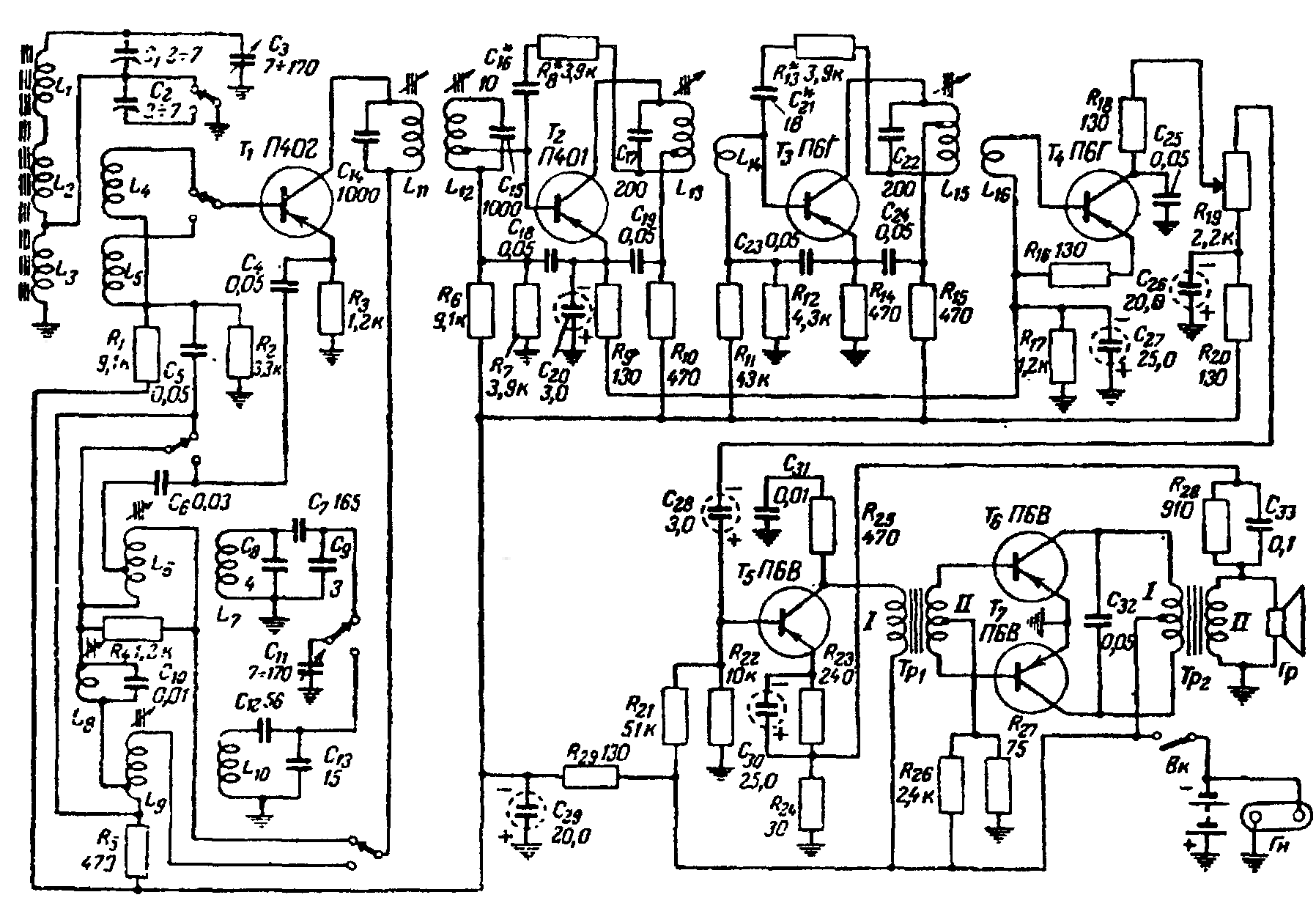
Fig. 15 “Sputnik” radio receiver circuit (1957).
In the circuit, you can easily find P401, P402, and other transistors. The first samples were produced in April 1957, 5 months before the launch of Sputnik-1. The case was made of dried pine, impregnated with an alcoholic solution of cellulose, and covered with decorative plastic.

Fig. 16 Transistor radio "Sputnik"
Dimensions - 185x125x49 mm, weight with batteries - 950 g. There was a solar battery on the upper edge of the case! The cost of the device was 514 rubles - it was about the average salary of a worker at that time.
So because of the lack of data on the Satellites there was a confusion with the "Satellites".
Next year 2017, we (Russia and the whole world) will celebrate the 60th anniversary of the launch of the First and Second artificial satellites of the Earth. I would like to refer to the management of Russian Space Systems JSC with a proposal to publish by this time a report on the Sputnik-2 and Sputnik-3 systems, since it is obvious that this is of great historical importance not only for the space industry, but also for electronic industry of Russia, which is alive, no matter what.
The superiority of the Soviet space technology over the American one involuntarily played against the development of domestic transistors, since there were suitable radio tubes that made it possible to solve the existing problems without worrying about saving dimensions and mass in the way that Americans had to do. As a result, looking back, we can see how far NASA’s automatic space systems, which are currently actively engaged in research of the Solar System (Mars, Jupiter, Saturn, Pluto ...), have gone ahead. The European Space Agency ESA, which is actively involved in small-sized satellites (micro- and nano-satellites), is not far behind. It is unlikely that a person will master the solar system in the coming decades, but this can be done by the human mind with the “hands” of automatic devices possessing the necessary “intelligence”. After the decline of 1990-2000,in spite of certain successes of domestic developers, Russia is sorely lacking its own microchips capable of solving the computational tasks of the modern level or even the level of tomorrow (after all, space projects are planned for several years) and possessing the necessary radiation resistance and failure resistance. And the problem here is not so much in the existing technological lag, but in the absence of a common understanding of the appearance of such computing systems and, therefore, in the lack of not only the electronic component base, but also reliable and effective software. You can not repeat the mistakes of the past - you need to learn from them.capable of solving computational problems of the modern level or even the level of tomorrow (after all, space projects are planned for several years) and possessing the necessary radiation resistance and failure resistance. And the problem here is not so much in the existing technological lag, but in the absence of a common understanding of the appearance of such computing systems and, therefore, in the lack of not only the electronic component base, but also reliable and effective software. You can not repeat the mistakes of the past - you need to learn from them.capable of solving computational problems of the modern level or even the level of tomorrow (after all, space projects are planned for several years) and possessing the necessary radiation resistance and failure resistance. And the problem here is not so much in the existing technological lag, but in the absence of a common understanding of the appearance of such computing systems and, therefore, in the lack of not only the electronic component base, but also reliable and effective software. You can not repeat the mistakes of the past - you need to learn from them.lack of not only electronic component base, but also reliable and effective software. You can not repeat the mistakes of the past - you need to learn from them.lack of not only electronic component base, but also reliable and effective software. You can not repeat the mistakes of the past - you need to learn from them.
On November 3, 1957, the Soviet Union launched the Second artificial satellite of the Earth with the first living “passenger” - the dog Laika. The sensational success and secrecy of the projects are still left “behind the scenes” by the outstanding achievements of specialists in the field of electronic equipment, whose participation in the space race by Russian literature is practically not considered, which is completely unfair.
What are we talking about?
- Where is the log?
- God knows, they say, on the satellite macaque card.
Transfer:
- Where is the captain Derevianko?
- I don’t know, but they say that it works through a closed communication channel and monitors the American tests of the prototype Mk-48 torpedo.
')
Joke
A curious fact: from the beginning of the first flights of man (not into space - just the first flights of the Wright brothers) until the launch of the Soviet Sputnik-1 took about the same time as after Sputnik-1 to our days. George Ludwig 1 (George H. Ludwig) 1 in his book [2] notes that space themes have become firmly established in our life, while the original meaning of the terms in everyday life was quite noticeably distorted: for example, when people say “bring a transistor here”, they often have It means a transistor radio, and the words “turn on the satellite” should be understood as connecting to satellite communications.

Fig. 1 Russian fans at the 2011 Rugby World Cup are cheering on their team, waving a banner reading: “We won the space race.” (Mike Hewitt / Getty Images) [3] .
Few people know and remember that space exploration is not only the development of rocket engines, spacecraft and life support equipment for astronauts (astronauts, taikonauts ...), but also sophisticated electronic equipment, with more or less intelligence, more or less high-tech "element base" (transistors, resistors, relays ...). The instrumental race in space is sometimes no less interesting than the race that we used to call space. And the consequences of this race are not obvious both to the broad masses, and, admittedly, to specialists.
On the Internet, in particular, on Wikipedia [4] , one can read that the first transistors in space were used in the first American satellite Explorer 1. On the Soviet satellites, they appeared in a limited number not starting from Satellite-3 (launched on May 15, 1958 ) [5] , not at all from Luna-3 (launched on April 20, 1960) 2 [6] . True, there are allegations that P401 fused-diffusion transistors appeared already in the transmitter of the first artificial Earth satellite [7] , [8] and, thus, “our successes in space and in transistors appeared to the world at the same time” [8] . But there are skeptics who believe that transistors on the first Soviet artificial satellites simply could not be, since our country "was far behind" technologically from the United States and in special-purpose equipment, at least until the late 1970s lamps. As an argument, supporters of this version cite the AVM-25 on-board computer calculator of the MiG-25 fighter, which in 1976 stole VI in Japan. Belenko. The AVM-25 car was not only on the lamps - it was analog 3 , which for cool Internet cushions (that is, non-specialists) is tantamount to sentencing. Why it was so - the topic of a separate article. The conviction that domestic electronics and microelectronics lagged far behind the western one, and now they are completely dead, is quite common. What are the jokes on the topic of "the largest microelectronics in the world", "chips with four legs and two carrying handles", "domestic microprocessor on lamps", etc.
Let's try to deal with the aspect of the space race associated with the use of transistors, that is, in fact, with the beginning of the use of semiconductor electronics in space. We will try to find the sources of the myths that have arisen and, if possible, dispel them, at least in the part concerning the equipment of the first satellites.
First transistors
The equipment intended for satellites must meet increased requirements for dimensions, mass, power consumption and reliability, so it is not surprising that it was semiconductor transistors that were considered active elements of electronic transmitting devices in both the USSR and the USA. time crystal triodes). In the book by E.Ya. Pumper “Crystal Diodes and Triodes” of 1953 [10] 4 shows a photograph that vividly demonstrates the comparative dimensions of a vacuum tube and a transistor.

Fig. 2 Comparison of the lamp and the semiconductor transistor from [10] .
In the time since the invention of the transistor Shockley, Bardin and Brattein in the late 1940s and before the beginning of the space age, transistors have changed quite noticeably. Dot transistors were supplanted by planar, planar - floatable, and so on, until they were all supplanted by planar [11] . Silicon transistors supplanted germanium, although not immediately. The first silicon transistor was made in 1954 by Texas Instruments [12] 5 , and, looking ahead, the transistors of this particular company were used in the first American satellites [14] .

Fig. 3 Bardin, Shockley and Brattein in the Bell Lab

Fig. 4 Alloy transistor. Square plate - base, on the one hand, an emitter bead is welded to it, on the other - a collector bead (from Wikipedia)
Semiconductor production in the USSR began in 1947 with a line for the production of germanium detectors for radar, exported from Germany. The group under the direction of A.V. Krasilov in NII-160 (now - JSC "NPP" Source "them. Shokina) was engaged in development. S.G. Madoyan - a graduate of the Moscow Institute of Chemical Technology - in 1948-1949. developed a model of the first point germanium transistor in the USSR [15] , [16] . The first laboratory sample worked no more than an hour, and then required a new setting [15]
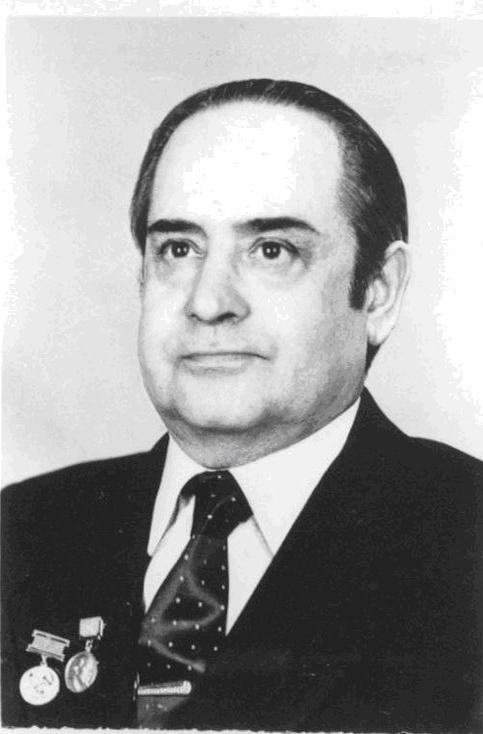 Fig. 5 Alexander Viktorovich Krasilov | 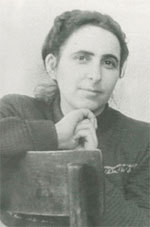 Fig. 6 Susanna Gukasovna Madoyan. 1950 |
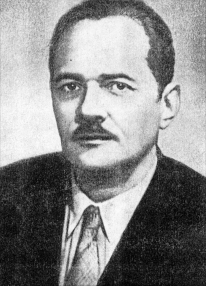 Fig. 7 Vadim E. Lashkaryov | 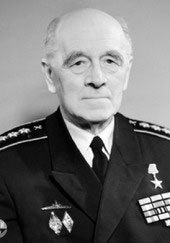 Fig. 8 Academician Axel Ivanovich Berg |
In 1950, the transistor theme appeared in the Central Research Institute-108 MO (now the Central Research Institute for Radio Engineering named after Academician A. Berg JSC), the Physics Institute of the Academy of Sciences, the Leningrad Physical-Technical Institute and other organizations. The first point transistors are made by V.E. Lashkaryov in the laboratory at the Institute of Physics of the Academy of Sciences of the Ukrainian SSR. Because of the secrecy of research, often at that time different research groups did almost the same thing, obtained similar results and made discoveries independently of each other. This situation lasted until November 1952, when a special issue of the American journal Proceedings of IRE, now Proceedings of IEEE, was published, entirely devoted to transistors [15] . At the beginning of 1953, the Deputy Minister of Defense, Academician A.I. Berg, prepared a letter to the CPSU Central Committee on the development of transistors, and in May, the Minister of Telecommunications Industry, M.G. Pervukhin, held a meeting in the Kremlin on semiconductors, at which they decided to organize specialized research institute of semiconductor electronics (NII-35, now NPP "Pulsar"). In the "Pulsar" transferred laboratory A.V. Krasilova, in which they created the first prototype in the USSR of a germanium plane ("layered") transistor. This development formed the basis of serial devices P1-P3 (1955) and their modifications [15] .
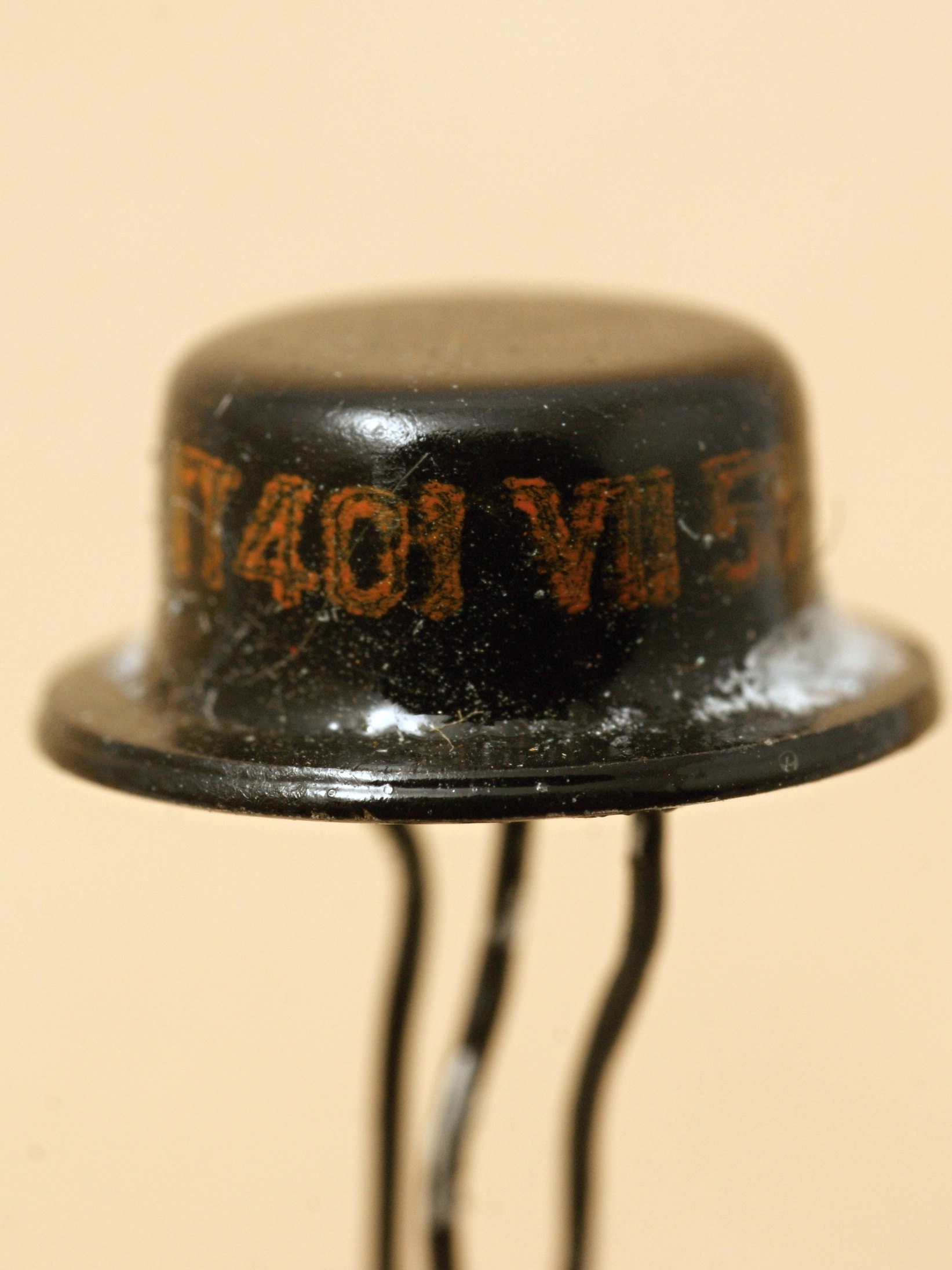 | 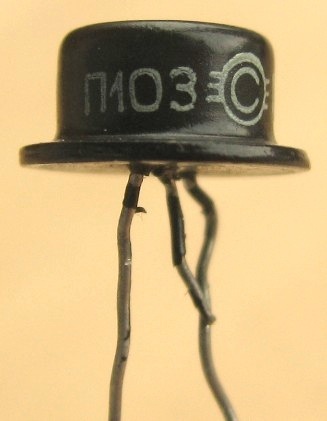 |
Fig. 9 The first germanium and silicon Soviet transistors
The first silicon alloy transistors appeared in the USSR in 1956 (104-106), then in 1956-1957. - germanium P401-P-403 (30-120 MHz), and also P418 (500 MHz). As we see, the launch of the first artificial satellite of the Earth in the USSR was the production of both germanium and silicon transistors, although even the 1960s, the percentage of usable silicon transistors output was only 19.3% [15] . According to [15] , in 1957, the Soviet industry produced 2.7 million transistors (for comparison, in the United States, the output of transistors this year was 28 million, and the number of different types reached 600). The first germanium transistors worked in the temperature range up to +85 o C [11] 6 and their characteristics were unstable, which turned away from the transistors both the military and the political leadership of the USSR.
Transistors and military
Among the “transistor builders” is a popular story, according to which transistors are widespread, thanks to the ingenuity of inventors who have declared that the transistor cannot be used for “special applications” and the military short-sightedness [17] . Apparently, this story has a real basis.
The creators of the first transistor could not know everything that he would be capable of, but the Bell Labs administration understood that the significance of this discovery was enormous, and did everything in its power to find out about the discovery in scientific circles [18] . On June 30, 1948, a large press conference was appointed to announce the opening. But before showing the transistor to the public, it had to be shown to the military. It was hoped that the military would not classify this development, but it was clear that they could do it. On June 23, Ralph Bown 7 showed a transistor to a group of officers. He showed a crystal with wires and the fact that it can amplify an electrical signal more effectively than a massive vacuum tube. He also told them that they were going to hold exactly the same demonstration in a week, without formally asking them for permission. The military discussed this issue among themselves after the demonstration, but in the end, none of them spoke in favor of classifying this topic. Either because of his own short-sightedness, or as an additional protection against the encroachments of the military, it was stated that "the transistor is expected to be used in hearing aids for the deaf ”) [19] . As a result, the press conference was held without interference [20] . The New York Times magazine posted a note on the transistor on page 46 in the Radio News section after a “lengthy note on the resumption of reporting by an incomparable Miss Brooks” [17] .
In early September 1951, Bell Labs held symposia in Murray Hill, New Jersey, during which engineers explained in a fairly general way how to make point transistors, and talked about current progress with alloy transistors. At the same time, nothing was said about the specific manufacturing process and military applications. The first symposium was attended by over 300 people (mostly military), each of whom paid a contribution of $ 25,000 (twenty-five thousand dollars in 1951 8 ) [21] . Many firms wanted to produce transistors on their own rather than buy them, and many succeeded. Philips manufactured a transistor at all without attending these seminars, using only information from American newspapers. It should be noted that AT & T did not contribute, but did not prevent other companies from producing transistors [21] .
In 1951, there were only four US transistor companies for commercial applications: Texas Instruments, International Business Machines (IBM), Hewlett-Packard and Motorola. They received licenses for those same $ 25,000 with low royalties. They were invited to the second symposium in April 1952, where the secrets of making transistors were fully disclosed. By 1952, there were eight manufacturing firms, by 1953 - fifteen, and by 1956 there were at least twenty-six companies producing germanium transistors, with an income of more than $ 14 million a year. In this case, the US military was the main consumer of transistors. In 1952, semiconductor manufacturers from Bell Labs signed military contracts worth over $ 5 million [21] . The share of research funding (R & D, Research and Development) from the military from 1953 to 1955 increased to 50% [22] .
With all this, the future of semiconductors for the military remained unclear, because the transistor was “noisy” compared to lamps, it withstood smaller loads, could be damaged by sudden voltage surges, its characteristics were unstable in the temperature range, and the frequency range was relatively narrow. The situation was aggravated by a wide variation of parameters between two transistors. The price of transistors was also high: the first samples were worth $ 20, by 1953 they had fallen in price to $ 8, while the lamps were worth about $ 1 [21] . Fairchild Semiconductor silicon mesa transistors were sold by IBM in the amount of 100 pieces for $ 150 (each) in 1958 - while Germanic transistors cost less than $ 5 at that time [23] . In the mid-1960s, these same transistors began to cost less than 10 cents per share [24] .
What about hearing aids? They actually appeared in the United States in 1952-1953 [25] , [21] , and this was the first non-military use of the transistor. AT & T issued free licenses for use in hearing aids to commemorate the work of Alexander Bell with the deaf [21] .
Unfortunately, this story has a little-known sad continuation, which concerns the Soviet Union already. Professor Ya.A. Fedotov (author of one of the first monographs on transistors in 1955 [26] ) in 1994 in the article “Electronics SOS!” [27] mentions a “murderous” sentence that was carried out at a meeting of the Council of Ministers of the USSR in 1956: “Transistor never will not enter into serious equipment. The only promising area of application for him is hearing aids ... ". Familiar expressions, is not it? Fedotov writes: "This distrust of the transistor and the craving for the old tube technology were explained by the lack of understanding of the new situation in electronics." And this is a year before the launch of the first satellite! Thus, everything that the American "transistor builders" avoided and successfully avoided, turned upon domestic ones: secrecy, lack of centralization, and a lack of understanding of the prospects by the top political leadership of the USSR. Obviously, in such conditions, the transistors had little chance of getting on board.
If not a transistor, then what?
Was there an alternative to transistors? After all, again, "on board" you can not put any device, but only with the required characteristics of reliability. The alternative appeared in the late 1940s, i.e. almost simultaneously with transistors, in the form of rod radio tubes. Due to the secrecy of the topic, it is quite difficult to track the history of the invention and development of this type of radio tubes, and often have to be content with information from online forums [28] .
June 1946. The USSR Council of Ministers entrusts Plant 617 (in the near future with the All-Union Research Institute No. 617 (NII-617) with an experimental plant of the State Committee of the Council of Ministers of the USSR on Radio Electronics) in Novosibirsk, the development of ultra-miniature and extra-strong lamps for onboard computer systems of aviation equipment. VN was appointed to lead the work. Avdeeva.

Fig. 10 Valentin Nikolaevich Avdeev
Valentin Nikolaevich Avdeev was born on May 16, 1915 in the city of Kotelnich of the Vyatka province. After receiving primary education, he worked at the Svetlana plant (now PJSC Svetlana) in Leningrad. He graduated from the factory technical school, then studied at the All-Union Correspondence Institute of Technical Education in 1934-1938. In 1941, he was sent for an internship in the USA for half a year (to the plants of Radio Corporation of America, RCA) to study the production of radio tubes. When the Great Patriotic War began, together with the staff of the plant was evacuated to Novosibirsk. There he worked first as a site master, from 1942 - chief engineer of the plant, from 1943 - deputy head of the laboratory. Subminiature radio tubes were developed by the design bureau of the plant 617 by 1947, and from 1948 secret production began. Since 1949, the work "Molecule" on the creation of ultra-miniature lamps of increased vibration resistance has been opened. On the basis of the laboratory number 1 created NII-617, the director of which is appointed Avdeev.
Rod tubes were practically free from the drawbacks of the "ordinary" tubes and, unlike the transistors of that time, could work in the full temperature range. A series of radio tubes was created: 1 17, 1 18, 124, 129 and 124. In 1960, the magazine [ Radio ] published an article [29] devoted to the principles of operation of rod radio tubes, in which the advantages of this type were noted, as well as the limiting frequency of more than 200 MHz was declared, which more than met the requirements for the frequency of receiving radio signals from the first artificial satellite Earth (see [30] ).

Fig. 11 Comparison of “ordinary” and rod radio tubes from an article in the magazine “Radio” [29]
For the creation of rod radio tubes V.N. Avdeev was elected a corresponding member of the USSR Academy of Sciences in 1958 (the same year that SP Korolev was elected a full member). This is despite the fact that V.N. Avdeev never defended dissertations - neither the candidate, nor the more doctoral.
The authors of the article in the magazine “Radio” complain: “Several years ago, when semiconductor devices appeared, some radio specialists were inclined to immediately“ bury ”the electronic lamp. The lamp, which for decades brought electronics to one triumph after another, suddenly revealed many shortcomings ... An electronic lamp compared to a semiconductor triode undoubtedly has several disadvantages, but the remarkable advantages of the lamp are well known ... ". And they add: “Unfortunately, it is necessary to note that the question of the scale of use, and, consequently, the production of rod-shaped lamps, is not resolved sufficiently quickly, despite the fact that these lamps have existed for many years and were highly appreciated.” In these words - a clear distrust of the "newfangled" transistors.
Rod radio tubes were used not only in space and aviation - they were used to create radio stations for the GRU and KGB special forces (R-353 Proton), a portable radio station R-126, a complex of MARS radio stations for the Ministry of Internal Affairs, etc. [31 ] .
Transistors in the first satellites
Soviet Army's RED STAR:
Uncle Sam thought of launching a Sputnik into the sky.
He didn’t announce it.
The boastful and rich uncle called his Sputnik Vanguard.
The name was beautiful and quite chic,
But it turned out to be pshik.
From the compilation of Time magazine about the reaction of the world media to the unsuccessful launch of the American Avangard satellite on December 16, 1957. VANGUARD'S AFTERMATH: JEERS AND TEARS Monday, Dec. 16, 1957 [32]
Our country launched not only the first artificial satellite of the Earth (and then brought the first man into space), but after the first satellite, 2 full-fledged space laboratories were launched within 7 months - Satellite-2 with Laika and Satellite-3, with the help of which in particular, natural radiation belts were discovered Zamlí 9 . The American first satellite Explorer 1 was 3 months ahead of Sputnik-3, however, by its “functional” characteristics it was closer to Sputnik-1, and its weight was almost 4 times smaller. The launch of Sputnik-1 caused the deserved respect of scientists, bewilderment and even the fear of the inhabitants in the West, the universal joy and triumph in the USSR and the storm of emotions of politicians. I will cite only two characteristic statements by Soviet and American politicians (I quote from [34] ). First Secretary of the CPSU Central Committee N.S. Khrushchev: “It seems that the name Avangard reflected the confidence of the Americans that their satellite would be the first in the world. But ... our Soviet satellite became the first, it was he who was in the vanguard ... ". Senator and future US president Lyndon Johnson: "I do not believe that this generation of Americans wants to come to terms with the situation when they have to fall asleep every night under the light of the communist moon." Not surprisingly, the space race has become fierce.
For clarity, the table below presents the launch dates and the main mass-dimensional characteristics of the first artificial earth satellites.
| Launch date | Title | A country | Dimensions | Weight, kg |
| 10/4/1957 | Sputnik-1 | the USSR | ~ 58 cm (without antennas) | 83.6 |
| 11.11.1957 | Sputnik-2 | the USSR | 2 mx 4 m | 508 |
| 02/01/1958 | Explorer 1 | USA | about 1 m in length | 21.5 |
| 03/17/1958 | Vanguard-i | USA | 16.3 cm (without antennas) | 1,474 |
| 03.26.1958 | Explorer 3 | USA | about 2 m long | 13.97 |
| 05/15/1958 | Satellite-3 | the USSR | 1.73 mx 3.57 m | 1327 |
Echoes of the bitterness of the race can be heard now. So, in 2015 (No. 138), National Geographic Russia published a short, but very remarkable for its unprofessional engagement, note “Satellite Avangard-1”: still in the forefront. I cite it completely: “In size with a melon and weighing about a kilogram, Avangard-1 became the first solar-powered satellite and an important step for the US in the space race. Trying to catch up with the Soviet Union, which launched Sputnik-1 and Sputnik-2 in 1957, the United States sent to the Avangard-1 orbit on March 17, 1958. Khrushchev pejoratively called it "grapefruit". However, the larger "Satellites" descended from orbit and burned when they entered the atmosphere in 1958, and the Avangard-1 still flies. He stopped data transmission in 1964, when the last photocells failed. But the device retains the title of the oldest artificial satellite in orbit and is projected to last there for another 240 years ”(end of quotation) [35] . With all due respect to National Geographic and the American developers of Avangard-I, I think that there are no comments here.
Let's go back to the transistors. As we have already noted, some authors claimed that transistors appeared already on Sputnik-1, and even brought the type of transistor - 401 [8] , [7] . The site [15] also gives this statement, although it makes a reservation that the use of core radio tubes is more likely. For a long time, different enthusiasts in different forums tried to understand what was happening, but it was almost impossible to sort it out until the publication of the Russian Space Systems (former NII-885) publication of the Satellite-1 report. I don’t have the text of this publication, but they cite it in the magazine Radio (No. 4, 2013) [36] , where the transmitter of the first artificial satellite of the Earth is also given:

Fig. 12 Diagram of the main transmitter “Satellite-1” at 20 MHz
There is not a single transistor on the circuit, but there are 2P19B rod radio tubes. So, right, those who believe that the first transistors appeared only in the American Explorer 1?

Fig. 13 William Pickering, James Van Allen and Werner von Braun demonstrate the full-scale model of the Explorer 1 satellite at a press conference in Washington after confirming the satellite’s launch into orbit

Fig. 14 George Ludwig with Backup Explorer 1
This question was directly asked by George Ludwig, the developer of systems Explorer 1 [37] . He replied that he used to really think so, but then investigated this question in more detail and found out that although the Soviets did not use transistors in Satellite-1, they used them in one of the devices of Satellite-2, launched in November 1957. Ludwig laments: "Of course, they (the Soviets) had much more capacity and their carriers could take vacuum tubes and the batteries they needed." At the same time, he emphasizes that Explorer 1 was the first satellite whose equipment was fully transistors (recall that there were no devices like rod radio tubes in the United States at that time). The interview curator provides a link to the 2001 publication [38] , which states the following: “Sputnik-2 was a real scientific platform containing various electronic components. In addition to the radio transmitter and the cabin for the Laika, it contained detectors of solar ultraviolet radiation and X-rays, and instruments for the study of cosmic rays were mounted on the body of the rocket. ” And further: “Two identical detectors in the experiment with cosmic rays worked as recorders of scintillations caused by charged particles. The pulses were counted by a semiconductor (based on triodes) circuit ... “. Unfortunately, the article does not contain a link to the source of this information.Alas, Sputnik-2 and Sputnik-3 happen to be confused in foreign literature (for example, it happened in [39] , although there is no confusion in an earlier article by one of the co-authors [40] ).
So in what Soviet device for the first time used transistors? Only about Satellite-3 is known for certain [5]. Sputnik-2 was launched just a month after Sputnik-1 - what is the probability of hitting transistors on board, in any capacity? Frankly speaking, it is small, considering not only the attitude towards the transistors in the leadership of the USSR, but also other considerations. As noted earlier, germanium transistors (namely, they were mainly produced by the Soviet industry and were known enough to judge reliability) are unstable in the temperature range, and where temperatures above +85 o C are needed , they were not used. On the other hand, American germanium transistors suffered from the same diseases [37], but according to Ludwig, they were used in Explorer 1 along with silicon ones, since germaniums had a lower base-emitter voltage (0.2 V vs. 0.5 V for silicon), therefore in a number of schemes with a supply voltage of 2.8 V it is their 10 .
First transistor radios
Allow me, but where does the mention of transistor P401 next to the Satellite come from? In fact, given the recommended frequency of the Satellite 40 MHz [30] and the fact that the limiting frequency of P401 was 30 MHz, it is difficult to imagine this transistor as a candidate for installation on board. The reason why this transistor is mentioned in the context of the Satellite may be comical. Remember the remark that in everyday life confused transistor and transistor radio? So, in 1957, at the Voronezh Radio Factory, they began to produce the Sputnik radio receiver, the circuit of which is shown below [41] .

Fig. 15 “Sputnik” radio receiver circuit (1957).
In the circuit, you can easily find P401, P402, and other transistors. The first samples were produced in April 1957, 5 months before the launch of Sputnik-1. The case was made of dried pine, impregnated with an alcoholic solution of cellulose, and covered with decorative plastic.

Fig. 16 Transistor radio "Sputnik"
Dimensions - 185x125x49 mm, weight with batteries - 950 g. There was a solar battery on the upper edge of the case! The cost of the device was 514 rubles - it was about the average salary of a worker at that time.
So because of the lack of data on the Satellites there was a confusion with the "Satellites".
And what follows from this?
Next year 2017, we (Russia and the whole world) will celebrate the 60th anniversary of the launch of the First and Second artificial satellites of the Earth. I would like to refer to the management of Russian Space Systems JSC with a proposal to publish by this time a report on the Sputnik-2 and Sputnik-3 systems, since it is obvious that this is of great historical importance not only for the space industry, but also for electronic industry of Russia, which is alive, no matter what.
The superiority of the Soviet space technology over the American one involuntarily played against the development of domestic transistors, since there were suitable radio tubes that made it possible to solve the existing problems without worrying about saving dimensions and mass in the way that Americans had to do. As a result, looking back, we can see how far NASA’s automatic space systems, which are currently actively engaged in research of the Solar System (Mars, Jupiter, Saturn, Pluto ...), have gone ahead. The European Space Agency ESA, which is actively involved in small-sized satellites (micro- and nano-satellites), is not far behind. It is unlikely that a person will master the solar system in the coming decades, but this can be done by the human mind with the “hands” of automatic devices possessing the necessary “intelligence”. After the decline of 1990-2000,in spite of certain successes of domestic developers, Russia is sorely lacking its own microchips capable of solving the computational tasks of the modern level or even the level of tomorrow (after all, space projects are planned for several years) and possessing the necessary radiation resistance and failure resistance. And the problem here is not so much in the existing technological lag, but in the absence of a common understanding of the appearance of such computing systems and, therefore, in the lack of not only the electronic component base, but also reliable and effective software. You can not repeat the mistakes of the past - you need to learn from them.capable of solving computational problems of the modern level or even the level of tomorrow (after all, space projects are planned for several years) and possessing the necessary radiation resistance and failure resistance. And the problem here is not so much in the existing technological lag, but in the absence of a common understanding of the appearance of such computing systems and, therefore, in the lack of not only the electronic component base, but also reliable and effective software. You can not repeat the mistakes of the past - you need to learn from them.capable of solving computational problems of the modern level or even the level of tomorrow (after all, space projects are planned for several years) and possessing the necessary radiation resistance and failure resistance. And the problem here is not so much in the existing technological lag, but in the absence of a common understanding of the appearance of such computing systems and, therefore, in the lack of not only the electronic component base, but also reliable and effective software. You can not repeat the mistakes of the past - you need to learn from them.lack of not only electronic component base, but also reliable and effective software. You can not repeat the mistakes of the past - you need to learn from them.lack of not only electronic component base, but also reliable and effective software. You can not repeat the mistakes of the past - you need to learn from them.
Notes
1 Van Allen belts.
2 Rudolf Bakitko, Head of Department, JSC Russian Space Systems: “It was the first transceiver. He worked in the ultrashortwave range, which was created in NII-35 and immediately brought to us.
3 , „“ „--“,
2010 [9] .
4 : 11 1953 , .. , „“ ..
.
5 , 1958 Fairchild Semiconductor (., , [13] ). , 1954 Texas Instruments (grown-junction), Fairchild
1958 - 2N697, 1959 —
2N1613.
6 — -60 o C +125 o C. — -55 o C...+125 o C.
7 . . IEEE (IEEE Medal of
Honor) « ».
8 , : [21] . , , , $25000 1952 [22] .
9 (Van Allen belts), „ -“. [33]
10 Explorer 1 29 , . Western Electric WE 53194, 2N64, 2N328, 1N496 2N335. . [37]
[one] http://www.anekdot.ru/an/an0608/o060802.html , 2006, : 19.10.2016
[2] G. Ludwig, Opening Space Research: Dreams, Technology, and Scientific
Discovery, ser. Special Publications. Wiley, 2013. [Online]. Available:
books.google.ru/books?id=KjxofdQNdVoC : 19.10.2016
[3] Bigpicture, bigpicture.ru/?p=202699 , 2011, : 19.10.2016
[four] Wikipedia, en.wikipedia.org/wiki/Explorer_1 , : 19.10.2016
[five] space-vanguard.narod.ru/apparaty-sputniki.html , accessed: 19 October
2016.
[6] : « — !». . 2016. Accessed: 19 October 2016. <anchor>[7] Yu.A. , .. : “ ”, , pp. 123-144, 2007.
[eight] .. : “ 60- ”, : , pp. 30-32, 2008.
[9] Lenta.ru, “ ” ” lenta.ru
news/2010/10/08/souyz/, 2010, accessed: 19 October 2016.
[10] .. : . , 1953. URL gen.lib.rus.ec/book/index.php?md5=0C726CE8BADDC5FF9AE683A8A69DCB3A .
[eleven] . . , .. : . Directory. .: , 1990.
[12] Texas Instruments, www.ti.com/ww/eu/shapinginnovation , accessed: 19
October 2016.
[13] . : ().
www.koshcheev.ru/2016/06/13/hrushchev-mpe .
[14] Texas Instruments, www.ti.com/corp/docs/company/history/timeline
semicon/1950/docs/58orbit.htm, accessed: 19 October 2016.
[15] “ ,” www.155la3.ru .
[16] “ ,” statehistory.ru/1320
Razrabotka-pervykh-tranzistorov-v-SSSR/.
[17] . . : “ ”, , pp. 4-8, 2006.
[18] WF Brinkman, DE Haggan, and WW Troutman, “A history of the invention
of the transistor and where it will lead us,” IEEE Journal of Solid-State Circuits,
vol. 32, no. 12, pp. 1858–1865, Dec 1997.
[19] LB Ebert, “What the story of the invention of the transistor teaches us. about
21st century patent practice,” in J. Marshall Rev. Intell. Prop., 2008, pp. 80–89.
[20] M. Riordan and L. Hoddeson, Crystal Fire. The Invention of the Transistor and
the Birth of the Information Age. WW Norton & Company, 1998.
[21] D. Morton and J. Gabriel, Electronics: the life story of a technology. Johns
Hopkins University Press, 2007.
[22] TJ Misa, Leonardo to the Internet: Technology and Culture from the
Renaissance to the Present. JHU Press, 2013.
[23] L. Berlin, The Man Behind the Microchip: Robert Noyce and the Invention of
Silicon Valley. Oxford University Press, 2006
[24] RK Bassett, To the Digital Age: Research Labs, Start-up Companies, and the
Rise of MOS Technology. JHU Press, 2007.
[25] MED-EL, “Learn about the history of hearing aids,” www.medel .
com/blog/learn-about-the-history-of-hearing-loss-part-1/, December 2015,
accessed: 19 October 2016.
[26] .. : . .: , 1955.
[27] .. : “ „SOS“!”, , 1994.
[28] “ retrotexnika.ru,” www.retrotexnika-forum.ru/talk
viewtopic.php?f=1&t=513&start=150, accessed: 19 October 2016.
[29] . , . : “ . ”, , pp. 34-38, 1960.
[30] “ ,” , no. 7,p. 17, 1957.
[31] . , “ ,” sosnovka41.narod.ru/antonov/antonov.files/tandems.htm .
[32] content.time.com/time/magazine/article/0 ,9171,893768,00.html,
accessed: 19 October 2016.
[33] .. : . --. .: , 1999.
[34] . , . : . .: , 2006.
[35] National Geographic , “ «-1»: ,” www.nat-geo.ru/science/154124-sputnik-avangard-1-vse-eshche-v-avangarde ,
2015.
[36] , “ ,” , no. 4, pp. 55–56, 2013.
[37] “A transistor museum interview with dr. george ludwig,” www.semiconductormuseum.com/Transistors/LectureHall/Ludwig/Ludwig_Page5.htm .
[38] M. Williamson, “The early development of spacecraft electronics,” Engineering Science and Education Journal, vol. 10, no. 2, pp. 68–74, Apr 2001.
[39] S. Gerardin and R. Ecoffet, “Radiation effects in advanced components,” in
RADECS 2015 Short Course, 2015.
[40] R. Ecoffet, “Overview of in-orbit radiation induced spacecraft anomalies,” IEEE
Transactions on Nuclear Science, vol. 60, no. 3, pp. 1791-1815, June 2013.
[41] V. Pestrikov: “The First Soviet Transistor Radios”, Radiohobby, 2008.
2 Rudolf Bakitko, Head of Department, JSC Russian Space Systems: “It was the first transceiver. He worked in the ultrashortwave range, which was created in NII-35 and immediately brought to us.
3 , „“ „--“,
2010 [9] .
4 : 11 1953 , .. , „“ ..
.
5 , 1958 Fairchild Semiconductor (., , [13] ). , 1954 Texas Instruments (grown-junction), Fairchild
1958 - 2N697, 1959 —
2N1613.
6 — -60 o C +125 o C. — -55 o C...+125 o C.
7 . . IEEE (IEEE Medal of
Honor) « ».
8 , : [21] . , , , $25000 1952 [22] .
9 (Van Allen belts), „ -“. [33]
10 Explorer 1 29 , . Western Electric WE 53194, 2N64, 2N328, 1N496 2N335. . [37]
Discovery, ser. Special Publications. Wiley, 2013. [Online]. Available:
books.google.ru/books?id=KjxofdQNdVoC : 19.10.2016
2016.
news/2010/10/08/souyz/, 2010, accessed: 19 October 2016.
October 2016.
www.koshcheev.ru/2016/06/13/hrushchev-mpe .
semicon/1950/docs/58orbit.htm, accessed: 19 October 2016.
Razrabotka-pervykh-tranzistorov-v-SSSR/.
of the transistor and where it will lead us,” IEEE Journal of Solid-State Circuits,
vol. 32, no. 12, pp. 1858–1865, Dec 1997.
21st century patent practice,” in J. Marshall Rev. Intell. Prop., 2008, pp. 80–89.
the Birth of the Information Age. WW Norton & Company, 1998.
Hopkins University Press, 2007.
Renaissance to the Present. JHU Press, 2013.
Silicon Valley. Oxford University Press, 2006
Rise of MOS Technology. JHU Press, 2007.
com/blog/learn-about-the-history-of-hearing-loss-part-1/, December 2015,
accessed: 19 October 2016.
viewtopic.php?f=1&t=513&start=150, accessed: 19 October 2016.
accessed: 19 October 2016.
2015.
RADECS 2015 Short Course, 2015.
Transactions on Nuclear Science, vol. 60, no. 3, pp. 1791-1815, June 2013.
Source: https://habr.com/ru/post/398969/
All Articles